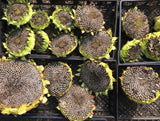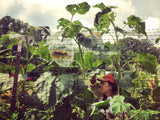Transylvanian Giant Sunflower Mix
Helianthus annuus
Impressively tall sunflowers - some with one large head, and some with lots of smaller heads on multiple branches. Transylvanian Giant Sunflower was shared with us by Uprising Seeds, who had gotten the variety in Transylvania from Romanian seed grower Jere Lajos. Lajos measured out the seeds in his father’s seed-measuring walnut shell - a family heirloom. Our variety must have crossed with another sunflower, since the original stock was not branched! For the single-headed variety, check out Uprising Seeds.
Sunflowers originate in North America, where it's seeds and pollen have been an important food crop and plant relative for indigenous people. Perhaps due to prohibitions against eating butter and lard during lent in the Russian Orthodox Church, Russians and Ukrainians grew fields and fields of sunflowers by the 1800s, and began breeding it for higher oil content. Consider welcoming this Transylvanian giant back home to North American soil as a striking pollinator- and bird-friendly backdrop to your farm or garden.
Days to maturity: 110
Seeds per pack: 50
Germination rate: 67% on 12/17/2021
Planting / harvesting notes
Sow seeds directly in full sun, keep soil from drying out, and thin seedlings to 18-24" apart. This species is an annual in most of North America, but may self-sow in subsequent years.
Seed keeping notes
To harvest the seeds, cut the dried, browned flowers flower heads into a paper bag. Dislodge the seeds by breaking apart the seedheads/flowers. Use a strainer to sift out the larger chaff. Use your breath, wind, or fans to winnow off lighter weight chaff. Birds will likely start eating the seeds as they develop, so consider how much you'd like to leave for them, and how much you would like to save for yourself. Best harvested for seed during a dry spell.











